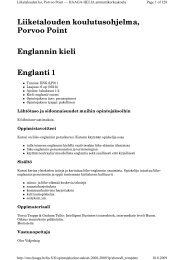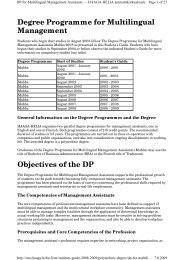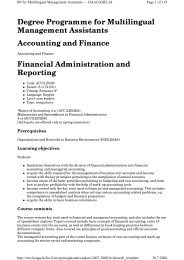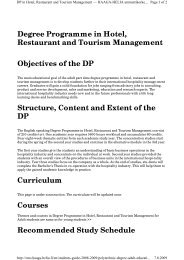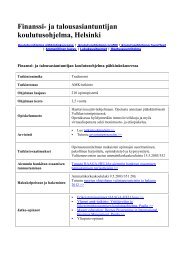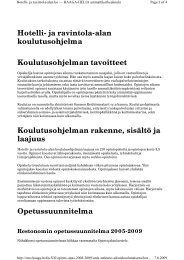Töissä - HAAGA-HELIA ammattikorkeakoulu
Töissä - HAAGA-HELIA ammattikorkeakoulu
Töissä - HAAGA-HELIA ammattikorkeakoulu
Create successful ePaper yourself
Turn your PDF publications into a flip-book with our unique Google optimized e-Paper software.
ARTICLE<br />
”Customers are companies’ best working-force”<br />
Get Your Customers<br />
‘Working’ for You;<br />
They Will Love it<br />
In today’s world customers are more valuable<br />
than ever. As customers have become experienced<br />
and multifaceted, and thus harder to classify,<br />
companies continue fighting ever harder to<br />
keep current customers and to acquire new ones. In<br />
my last contribution to <strong>HAAGA</strong>-<strong>HELIA</strong> SIGNALS , I<br />
recommended that companies stop being subservient<br />
to customers. Instead companies should encourage<br />
customers to chase them (and their offerings)<br />
by tempting, tantalising, teasing, and tormenting<br />
them (e.g. Sony has been a leader in teasing customers<br />
with a lust for electronics). In this issue I go<br />
further, and suggest that companies should put customers<br />
‘working’ for them as they will love it.<br />
The right to work is something man conquered<br />
relatively recently in the Western world (in many<br />
developing countries, starvation and misery are still<br />
part of the populations’ daily life). Since the XIX<br />
century, work is the mother of all virtues, changing<br />
man into ‘homo faber’, even though in recent decades<br />
man, via technological achievements and social<br />
revisions, has been liberated from work or part<br />
of it. Indeed, the right to be lazy through rest and<br />
play made man ‘homo ludens’. However, the love<br />
of work is an earnest desire and ubiquitous. I work,<br />
therefore I am.<br />
Workers in the service industry are increasingly<br />
acquiring power and responsibility so that, within<br />
specified limits, they are able to provide the best<br />
possible service experience (which satisfies customers).<br />
Empowerment of employees (Do-It-For-Me)<br />
is normally regarded as a critical factor in services.<br />
However, empowerment should not be only applied<br />
to staff, but also to customers (Do-It-Yourself).<br />
Do-It-Yourself, often referred to by the initials DIY,<br />
is a term used by various businesses that focus on<br />
customers creating/doing things for themselves. In<br />
short, by empowering customers companies put<br />
customers ‘working’ for them.<br />
There is certainly a growing trend in terms of proliferation<br />
of business models where customers are<br />
playing miscellaneous roles. Over the past decades<br />
DIY customers (DIY’ers) have evolved from relative<br />
obscurity to a major multibillion euro per year market.<br />
Companies doing business in carpentry, painting,<br />
electricity, gardening, plumbing, sewing, wall/<br />
floor covering, masonry, and others alike have been<br />
putting customers ‘working’ for them for quite<br />
some time. The IKEA business model represents a<br />
great understanding of DIY’ers.<br />
Another means with which companies put customers<br />
‘working’ for them is by offering self-serv-<br />
Ascenção, M. P. 2007. How to Move Away from the ‘Average-Fantastic’ in Hospitality. <strong>HAAGA</strong>-<strong>HELIA</strong> SIGNALS. Issue 1, pp. 14-16.<br />
TEXT MÁRIO PASSOS ASCENÇÃO<br />
Principal Lecturer<br />
<strong>HAAGA</strong>-<strong>HELIA</strong> University of Applied Sciences<br />
mariopassos.ascencao@haaga-helia.fi<br />
ice. Self-service is the practice of serving oneself,<br />
usually when purchasing items. Self-service is often<br />
described as a way of improving the customer experience<br />
by providing more choices, whilst eliminating<br />
inefficient customer interaction ‘bottlenecks’. For<br />
example, giving the option of using internet checkin<br />
allows customers to choose a less personal service<br />
that will, however, result in not having to stand in<br />
line and wait for the check-in clerk.<br />
Other common examples include petrol stations,<br />
where customer pump their own gasoline rather<br />
than have an employee doing it; Automatic Teller<br />
Machines (ATMs) in the banks that have revolutionised<br />
how customers withdraw and deposit money;<br />
shopping carts that customers use in the store, placing<br />
the items into the cart and then proceeding to<br />
the checkout counters; or buffet-style restaurants,<br />
where customers serve themselves, eventually returning<br />
the used tray; slow food businesses (cooking<br />
your own meal); grocery stores’ self-checkout lanes;<br />
self-service online booking sites; Internet banking<br />
and many more.<br />
It seems clear that instead of serving customers<br />
some companies allow them to serve themselves. In<br />
addition, with the help of technology, companies<br />
are increasingly finding new ways of eliminating<br />
12 13



